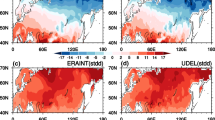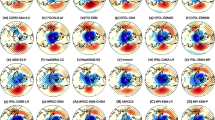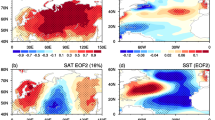Abstract
The second empirical orthogonal function mode (EOF2) of winter surface air temperature (SAT) over 0°–180° E, 40°–90° N during 1979–2005 is defined as warm Arctic-cold Eurasia (WACE) pattern. The present study evaluates the performance of 25 Coupled Model Inter-comparison Project Phase 5 (CMIP5) models in simulating the WACE pattern based on historical runs. There exist large inter-model spreads in the simulation of the WACE pattern. Analyses show that the ability of a CMIP5 model in capturing the WACE pattern is connected with the model’s performance in representing the observed atmospheric circulation anomalies related to the winter sea ice concentration (SIC) variation over Barents–Kara Seas. Sea ice loss over Barents–Kara Seas can induce significant positive geopotential height anomalies over Arctic region and negative geopotential height anomalies around the Baikal Lake, resulting in warm anomalies over Barents–Kara Seas and cold anomalies over Eurasia. Further analysis shows that CMIP5 model’s performance in representing the SAT anomalies related to the WACE pattern is partly due to simulation of the amplitude of winter SIC variability over Barents–Kara Seas. Larger standard deviations of winter SIC over Barents–Kara Seas can instigate stationary wave-train more easily, which further induces the SAT anomalies.















Similar content being viewed by others
References
Alexander MA, Bhatt US, Walsh JE, Timlin MS, Miller JS, Scott JD (2003) The atmospheric response to realistic Arctic sea ice anomalies in an AGCM during winter. J Clim 17:890–905
Balmaseda MA, Ferranti L, Molteni F, Palmer TN (2010) Impact of 2007 and 2008 Arctic ice anomalies on the atmospheric circulation: implications for long-range predictions. Q J R Meteorol Soc 136:1655–1664
Charlton-Perez AJ et al (2013) On the lack of stratospheric dynamical variability in low-top versions of the CMIP5 models. J Geophys Res Atmos 118:2494–2505
Chen Z, Wu R, Chen W (2014) Impacts of Autumn Arctic sea ice concentration changes on the East Asian Winter Monsoon variability. J Clim 27:5433–5450. https://doi.org/10.1175/jcli-d-13-00731.1
Chen S, Wu R, Song L, Chen W (2018) Present-day status and future projection of spring Eurasian surface air temperature in CMIP5 model simulations. Clim Dyn 52:5431–5449
Cohen JL, Furtado JC, Barlow M, Alexeev VA, Cherry JE (2012a) Asymmetric seasonal temperature trends. Geophys Res Lett 39:54–62
Cohen JL, Furtado JC, Barlow MA, Alexeev VA, Cherry JE (2012b) Arctic warming, increasing snow cover and widespread boreal winter cooling. Environ Res Lett 7:014007. https://doi.org/10.1088/1748-9326/7/1/014007
Cohen J, Jones J, Furtado J, Tziperman E (2013) Warm Arctic, cold continents: a common pattern related to Arctic sea ice melt, snow advance, and extreme winter weather. Oceanography. https://doi.org/10.5670/oceanog.2013.70
Cohen J et al (2014) Recent Arctic amplification and extreme mid-latitude weather. Nat Geosci 7:627–637. https://doi.org/10.1038/ngeo2234
Cohen J et al (2020) Divergent consensuses on Arctic amplification influence on midlatitude severe winter weather. Nat Clim Change 10:20–29. https://doi.org/10.1038/s41558-019-0662-y
Dee DP et al (2011) The ERA-Interim reanalysis: configuration and performance of the data assimilation system. Q J R Meteorol Soc 137:553–597. https://doi.org/10.1002/qj.828
Deser C, Magnusdottir G, Saravanan R, Phillips A (2004) The effects of North Atlantic SST and sea ice anomalies on the winter circulation in CCM3. Part II: direct and indirect components of the response. J Clim 17:877–889
Deser C, Tomas RA, Peng S (2007) The transient atmospheric circulation response to North Atlantic SST and sea ice anomalies. J Clim 20:4751
Fan K, Xie Z, Wang H, Xu Z, Liu J (2017) Frequency of spring dust weather in North China linked to sea ice variability in the Barents Sea. Clim Dyn. https://doi.org/10.1007/s00382-016-3515-7
Francis JA, Vavrus SJ (2012) Evidence linking Arctic amplification to extreme weather in mid-latitudes. Geophys Res Lett 39:L06801. https://doi.org/10.1029/2012gl051000
Francis JA, Chan W, Leathers DJ, Miller JR, Veron DE (2009) Winter Northern Hemisphere weather patterns remember summer Arctic sea-ice extent. Geophys Res Lett 36:157–163
Guo Y, Zhao Z, Dong W (2016) Two dominant modes of winter temperature variations over China and their relationships with large-scale circulations in CMIP5 models. Theor Appl Climatol 124:579–592
Honda M, Inoue J, Yamane S (2009) Influence of low Arctic sea-ice minima on anomalously cold Eurasian winters. Geophys Res Lett 36:L08707. https://doi.org/10.1029/2008gl037079
Hopsch S, Cohen J, Dethloff K (2012) Analysis of a link between fall Arctic sea ice concentration and atmospheric patterns in the following winter. Tellus A 64:18624. https://doi.org/10.3402/tellusa.v64i0.18624
Inoue J, Hori ME, Takaya K (2012) The role of Barents sea ice in the wintertime cyclone track and emergence of a Warm-Arctic Cold-Siberian anomaly. J Clim 25:2561–2568. https://doi.org/10.1175/jcli-d-11-00449.1
Jaiser R, Dethloff K, Handorf D, Rinke A, Cohen J (2012) Impact of sea ice cover changes on the Northern Hemisphere atmospheric winter circulation. Tellus A. https://doi.org/10.3402/tellusa.v64i0.11595
Jeong J-H, Ou T, Linderholm HW, Kim B-M, Kim S-J, Kug J-S, Chen D (2011) Recent recovery of the Siberian High intensity. J Geophys Res 116:D23102. https://doi.org/10.1029/2011jd015904
Johannessen OM et al (2004) Arctic climate change: observed and modeled temperature and sea-ice variability. Tellus A 56:559–560. https://doi.org/10.1111/j.1600-0870.2004.00092.x
Kim BM et al (2014) Weakening of the stratospheric polar vortex by Arctic sea-ice loss. Nat Commun 5:4646. https://doi.org/10.1038/ncomms5646
Kug JS, Jeong JH, Jang YS, Kim BM, Folland CK, Min SK, Son SW (2015) Two distinct influences of Arctic warming on cold winters over North America and East Asia. Nat Geosci 8:759–762. https://doi.org/10.1038/ngeo2517
Kushnir Y, Robinson WA, Bladé I, Hall NMJ, Peng S, Sutton R (2002) Atmospheric GCM response to extratropical SST anomalies: synthesis and evaluation. J Clim 15:2233–2256
Li F, Orsolini YJ, Wang H, Gao Y, He S (2018) Atlantic Multidecadal Oscillation modulates the impacts of Arctic sea ice decline. Geophys Res Lett 45:2497–2506
Liang YC et al (2019) Quantification of the Arctic Sea Ice-Driven Atmospheric Circulation Variability in Coordinated Large Ensemble Simulations. Geophys Res Lett 47:1. https://doi.org/10.1029/2019GL085397
Lindsay R, Wensnahan M, Schweiger A, Zhang J (2014) Evaluation of seven different atmospheric reanalysis products in the Arctic. J Clim 27:2588–2606
Liu J, Curry JA, Wang H, Song M, Horton RM (2012) Impact of declining Arctic sea ice on winter snowfall. Proc Natl Acad Sci USA 109:4074
Miao C et al (2014) Assessment of CMIP5 climate models and projected temperature changes over Northern Eurasia. Environ Res Lett 9:055007
Mori M, Watanabe M, Shiogama H, Inoue J, Kimoto M (2014) Robust Arctic sea-ice influence on the frequent Eurasian cold winters in past decades. Nat Geosci 7:869–873. https://doi.org/10.1038/ngeo2277
North GR, Moeng FJ, Bell TL, Cahalan RF (1982) The latitude dependenceof the variance of zonally averaged quantities. Mon Weather Rev 110:319–326. https://doi.org/10.1175/1520-0493(1982)110%3c0319:Tldotv%3e2.0.Co;2
Osprey SM, Gray LJ, Hardiman SC, Butchart N, Hinton TJ (2013) Stratospheric variability in twentieth-century CMIP5 simulations of the Met Office climate model: high top versus low top. J Clim 26:1595–1606
Overland JE, Wang M (2010) Large-scale atmospheric circulation changes are associated with the recent loss of Arctic sea ice. Tellus A 62:1–9. https://doi.org/10.1111/j.1600-0870.2009.00421.x
Overland JE, Wood KR, Wang M (2010) Warm Arctic—cold continents: climate impacts of the newly open Arctic Sea. Polar Res 30:157–171
Overland JE et al (2016) Nonlinear response of mid-latitude weather to the changing Arctic. Nat Clim Change 6:992–999. https://doi.org/10.1038/nclimate3121
Park DSR, Lee S, Feldstein SB (2015) Attribution of the recent winter sea ice decline over the Atlantic sector of the Arctic Ocean. J Clim 28:4027–4033
Peings Y, Magnusdottir G (2014) Response of the wintertime Northern Hemisphere atmospheric circulation to current and projected Arctic sea ice decline: a numerical study with CAM5. J Clim 27:244–264
Polyakov IV et al (2002) Observationally based assessment of polar amplification of global warming. Geophys Res Lett 29:1878. https://doi.org/10.1029/2001gl011111
Rayner NA et al (2003) Global analyses of sea surface temperature, sea ice, and night marine air temperature since the late nineteenth century. J Geophys Res 108:407. https://doi.org/10.1029/2002jd002670
Screen JA, Francis JA (2016) Contribution of sea-ice loss to Arctic amplification is regulated by Pacific Ocean decadal variability. Nat Clim Change 6:856–860. https://doi.org/10.1038/nclimate3011
Screen JA, Simmonds I (2010a) The central role of diminishing sea ice in recent Arctic temperature amplification. Nature 464:1334–1337. https://doi.org/10.1038/nature09051
Screen JA, Simmonds I (2010b) Increasing fall-winter energy loss from the Arctic Ocean and its role in Arctic temperature amplification. Geophys Res Lett 37:L16707. https://doi.org/10.1029/2010gl044136
Screen JA, Deser C, Simmonds I (2012) Local and remote controls on observed Arctic warming. Geophys Res Lett 39:L10709. https://doi.org/10.1029/2012gl051598
Screen JA, Simmonds I, Deser C, Tomas R (2013) The Atmospheric response to three decades of observed Arctic sea ice loss. J Clim 26:1230–1248. https://doi.org/10.1175/jcli-d-12-00063.1
Serreze MC, Barry RG (2011) Processes and impacts of Arctic amplification: a research synthesis. Glob Planet Change 77:85–96. https://doi.org/10.1016/j.gloplacha.2011.03.004
Sun L, Perlwitz J, Hoerling M (2016) What caused the recent “Warm Arctic, Cold Continents” trend pattern in winter temperatures? Geophys Res Lett 43:5345–5352. https://doi.org/10.1002/2016gl069024
Sung MK, Kim BM, Baek EH, Lim YK, Kim SJ (2016) Arctic-North Pacific coupled impacts on the late autumn cold in North America. Environ Res Lett 11:084016
Tang Q, Zhang X, Yang X, Francis JA (2013) Cold winter extremes in northern continents linked to Arctic sea ice loss. Environ Res Lett 8:014036. https://doi.org/10.1088/1748-9326/8/1/014036
Taylor KE (2001) Summarizing multiple aspects of model performance in a single diagram. J Geophys Res 106:7183–7192. https://doi.org/10.1029/2000jd900719
Taylor KE, Stouffer RJ, Meehl GA (2012) An Overview of CMIP5 and the experiment design. Bull Am Meteorol Soc 93:485–498. https://doi.org/10.1175/bams-d-11-00094.1
Wang L, Chen W (2013) The East Asian winter monsoon: re-amplification in the mid-2000s. Chin Sci Bull 59:430–436. https://doi.org/10.1007/s11434-013-0029-0
Wang S, Chen W, Chen S, Nath D, Wang L (2019) Anomalous winter moisture transport associated with the recent surface warming over the Barents–Kara seas region since the mid-2000s. Int J Climatol. https://doi.org/10.1002/joc.6337
Warner J, Screen JA, Scaife AA (2019) Links Between Barents-Kara Sea Ice and the Extratropical Atmospheric Circulation Explained by Internal Variability and Tropical Forcing. Geophys Res Lett 47:1. https://doi.org/10.1029/2019GL085679
Xu M, Xu H, Jing M (2016) Responses of the East Asian winter monsoon to global warming in CMIP5 models. Int J Climatol 36:2139–2155. https://doi.org/10.1038/ncomms5646
Zhang P, Wu Y, Simpson IR, Smith KL, Zhang X, De B, Callaghan P (2018) A stratospheric pathway linking a colder Siberia to Barents–Kara Sea sea ice loss. Sci Adv 4:eaat6025. https://doi.org/10.1126/sciadv.aat6025
Zygmuntowska M, Mauritsen T, Quaas J, Kaleschke L (2012) Arctic clouds and surface radiation—a critical comparison of satellite retrievals and the ERA-Interim reanalysis. Atmos Chem Phys 12:6667–6677
Acknowledgments
The authors highly acknowledge the scientific discussions and exchanges with scientists at Centre for Monsoon System Research, Institute of Atmospheric Physics. This work is supported jointly by the Ministry of Science and Technology of China (2016YFA0600604), Key Research Program of Frontier Sciences, CAS (QYZDY-SSW-DQC024), National Natural Science Foundation of China (Grant no. 41750110484, 41675061 and 41950410756).
Author information
Authors and Affiliations
Contributions
SW designed this study, DN and CW revised, interprets and gave valuable suggestions during this research. MT helps in data analysis and interpretation. All authors contributed ideas in developing this research, discussed the results and wrote this paper.
Corresponding author
Ethics declarations
Conflict of interest
The authors declare no competing interest.
Additional information
Publisher's Note
Springer Nature remains neutral with regard to jurisdictional claims in published maps and institutional affiliations.
Rights and permissions
About this article
Cite this article
Wang, S., Nath, D., Chen, W. et al. CMIP5 model simulations of warm Arctic-cold Eurasia pattern in winter surface air temperature anomalies. Clim Dyn 54, 4499–4513 (2020). https://doi.org/10.1007/s00382-020-05241-2
Received:
Accepted:
Published:
Issue Date:
DOI: https://doi.org/10.1007/s00382-020-05241-2




